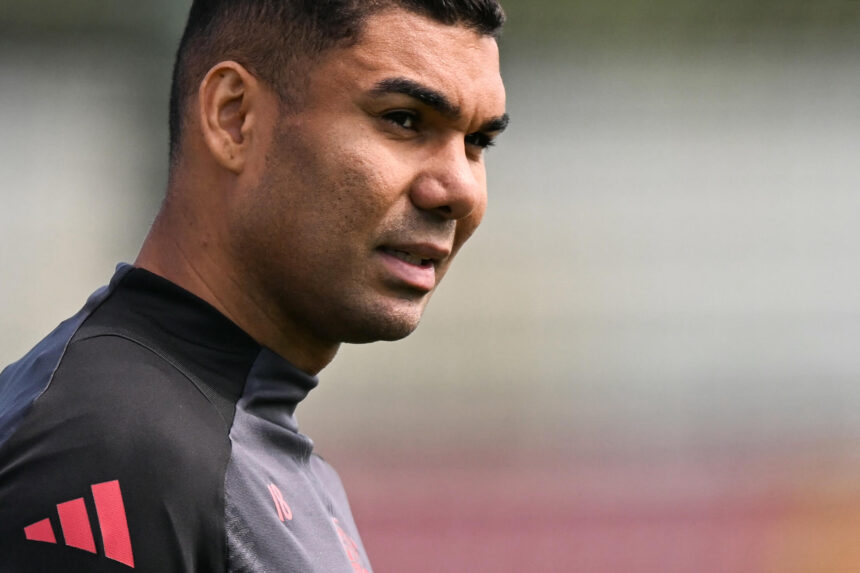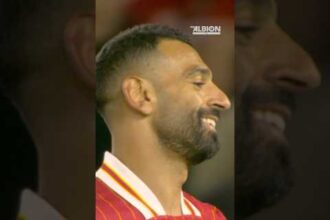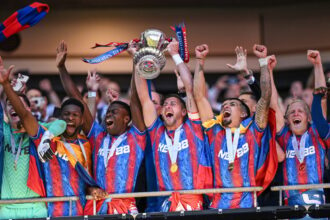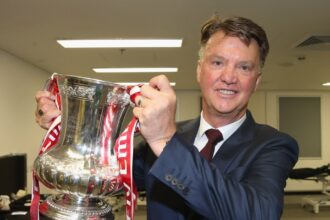If a team wishes to defeat Casemiro in a European final, they must prepare for extra time and penalties.
The 33-year-old is one of the most decorated defensive midfielders of a generation. Depending on which Spanish newspaper you prefer, he is either “a tank”, known for his courage and combative tackling style, or a cunning operator with a “cloak of invisibility” and a skill for avoiding bookings.
Advertisement
Across his time at Real Madrid, Casemiro picked up a habit for winning big trophies and coming alive in the biggest games. The Brazilian has played in eight European finals and come away with a runner-up medal only once: in a 4-2 extra time defeat by Atletico Madrid in the 2018 UEFA Super Cup.
This season’s Europa League has presented an interesting avenue for Casemiro to re-establish himself in a Manchester United shirt. How does a veteran find a way to win when everything feels like an uphill battle?
Casemiro knows how to win finals. If we look at his record for both Real Madrid and United, and include two-legged fixtures such as the Spanish Super Cup, his resume makes for remarkable reading: 14 wins, two defeats and three Opta-defined draws. (read: games that went to extra time and/or penalties.)
That 2018 UEFA Super Cup, 2023 FA Cup and this season’s Community Shield are the only occasions Casemiro has played and walked away from a final with a runner-up medal. Finals are matches he has a unique affinity for.
“I always say that the final part is always the most beautiful and the most important,” Casemiro told Telemundo Deportes prior to United’s 1-0 defeat by Chelsea last week.
“We know that in the Premier League, it didn’t go as we had hoped. Well, we have a great opportunity against Tottenham to bring happiness and joy not only to ourselves but also to the club and the fans. That is very important.”
Casemiro will likely start Wednesday’s Europa League final (Oli Scarff/AFP via Getty Images)
Casemiro’s time at United has seen pronounced peaks and valleys.
Signed in 2022 in a deal that could still yet reach £70million, his first season saw Erik ten Hag make Casemiro the cornerstone of his squad rebuild, describing him as “the cement between the stones”. It was his headed goal that opened the scoring in the 2023 Carabao Cup final, feeding into a win that would end the club’s six-year trophy drought.
Advertisement
Then came a 2023-24 season where injuries, both to Casemiro and the team as a whole, made his role in the side difficult. “I think Casemiro’s legs have gone,” opined former Liverpool defender and pundit Jamie Carragher partway through the campaign.
The midfielder spent the majority of the season either injured or playing in a starting XI depleted by injuries to others. He collected nine yellow cards and one red in 27 appearances, unable to cover the midfield spaces he patrolled so excellently in previous campaigns.
The nadir came during a 4-0 defeat by Crystal Palace, where Casemiro, deployed as a centre-back in an injury-depleted starting XI, was given twisted blood by Michael Olise in a humbling loss. He went on to be dropped from Brazil’s 2024 Copa America squad (he had previously been named captain) and missed the 2024 FA Cup final through injury.
The most recent summer transfer window saw Casemiro’s future at the club heavily discussed. A weekly wage thought to be north of £300,000 limited the scope for any moves away from United, even after the club signed Manuel Ugarte to bolster their options in defensive midfield.
Casemiro’s 2024-25 started tentatively, with the Brazilian starting Ten Hag’s first two Premier League games before being removed at half-time in a 3-0 defeat by Liverpool. Ruud van Nistelrooy’s interim period in charge of the club saw him laud Casemiro as an example to others but his position in the midfield hierarchy changed soon after Ruben Amorim’s arrival.
Casemiro was an unused substitute in nine out of 15 Premier League matches at the beginning of his new head coach’s tenure. An improvement in Bruno Fernandes’ passing and ball carrying under pressure saw the captain moved into the central midfield pivot alongside Ugarte in certain games while the emergence of academy graduate Toby Collyer also gave Amorim another option for the position.
Advertisement
And so it fell to the Europa League for Casemiro to reconjure some of his old glories and insert himself into Amorim’s plans. He took on the challenge well, starting every knockout game across United’s journey to the final. Following March’s 4-1 second-leg victory over Real Sociedad in the last 16, Amorim remarked that the team’s improved performances in the competition have roots in his improved understanding of the midfielder’s qualities.
“I think Casemiro gave us a little bit of calm,” said the United head coach following the result. “Sometimes, he takes a little bit long when he was not playing too much; you feel it in the game against Newcastle (a 2-0 loss in December). The pace was not there but he is giving that first moment of build-up, and then you can push Bruno near the goal, so he’s dangerous there.”
Casemiro still wants to bootstrap his team to success but he’s going about it differently compared to previous seasons. Amorim’s shift to a 3-4-3 system has brought changing responsibilities for everyone in the starting XI, including their veteran midfielder. It now falls to the back three and wing-backs to take on the lion’s share of build-up play in the United third, reducing the frequency Casemiro has to drop deep to collect the ball from his centre-halves.
He is also one of several players benefiting from the more measured pace of Europa League football, playing against defences unable to press him with the same ferocity found in the Premier League. This led to him playing a crucial role in each of the last three goals scored in last month’s 5-4 quarter-final second-leg victory over Lyon, including the cross to Harry Maguire for the winner. He followed that with United’s first goal to begin their semi-final second-leg win over Athletic Club. Signed to be United’s defensive wall, he has now become their Europa League catapult, firing difficult and dangerous passes into team-mates and causing some attacking damage of his own.
“You can see not the way he plays but the way he runs,” said Amorim following Casemiro’s performance in the second leg. “You can see it. We have the data to show him where he worked really hard. He is a very good example.”
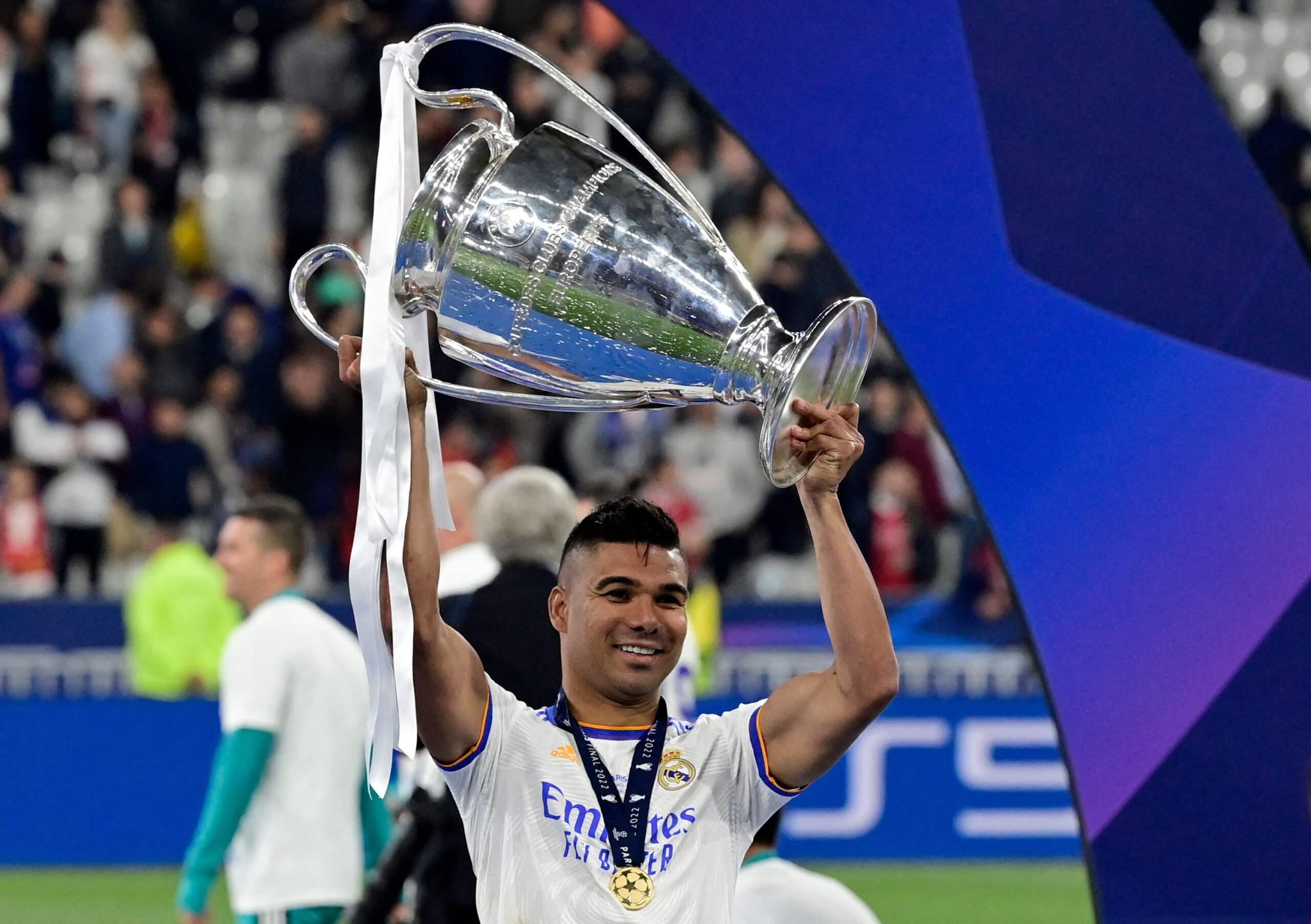
Casemiro was a serial trophy-winner at Real Madrid (Javier Soriano/AFP via Getty Images)
The change in shape has also brought about a reduction in the amount of space he has had to cover when out of possession. The 10-15 yard recovery sprints have been replaced by shorter defensive bursts.
“We understood that he cannot jump all the time pressing high,” explained Amorim following United’s 3-0 first-leg victory over Athletic Club. “We need to let him understand and sometimes it is better to put three defenders, and let him be the fourth defender and put the wing-backs pressing high.”
Advertisement
Casemiro also now has to pick and choose the most opportune moment to dent the opposition. A free-swinging defensive marauder has been replaced by a more considered warrior.
Tottenham Hotspur will provide a formidable foe for the midfielder and this United team as a whole. Spurs have beaten Amorim’s men three times already this season and play with the sort of high-intensity pressing football that has proven United’s weakness all season.
If Amorim’s men are to be successful in Bilbao on Wednesday, they will need Casemiro to be at his very best. It will fall to the Brazilian, along with Maguire, Fernandes and others, to bring their “veteran’s sensibility” to the game. The Europa League final presents a match-up against a physical Premier League side but it is also the sort of one-off game in a neutral venue that the Brazilian is well-acquainted with. As he said in 2018, “finals are not for playing, finals are for winning, however you can.”
This season’s Europa League has seen Casemiro find more sand for his hourglass on both sides of the ball and the former Real Madrid man is making the most of things. This summer may raise more questions about his future at United but, in the present, he has one further match to write another chapter in a trophy-laden story.
(Top photo: Oli Scarff/AFP via Getty Images)


